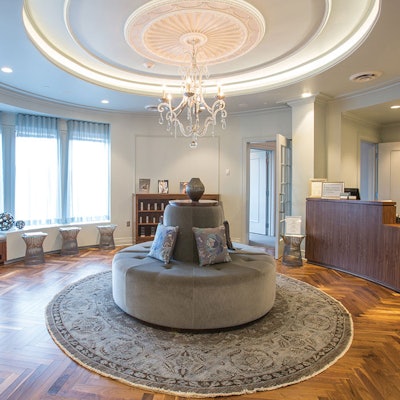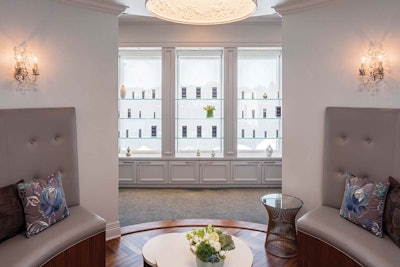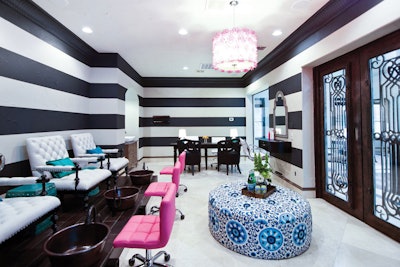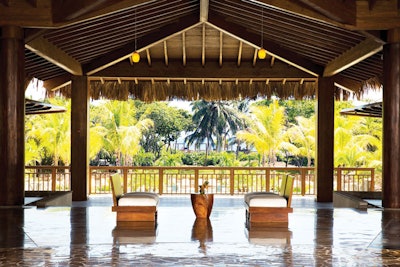
What makes today’s spa both memorable and fresh, a retreat for the body and a treat for the eyes and senses? In the past, it might have been the
luxurious furniture, elaborate water features or exquisite floral arrangements. But take a closer look at some of the newer design elements that make these healing havens so appealing, and you’ll likely notice that they’re deeply influenced by what’s trending all around us—especially when trying to attract the next generation of spa-goers.
The rising class of professional millennials, in particular, demands a new approach to pampering and wellness that addresses their individuality while keeping them engaged, entertained and inspired. What’s more, they want to share it all with their friends, both in person and on social media. The good news is that many of the recent developments that help deliver on these expectations can easily be incorporated into just about any space. Read on for all the details.

Spa guests have a growing desire for individualized experiences that can swiftly go from private and hushed to communal and festive, says New York City- based designer Nicole Migeon. This has challenged architects to rethink the way they build spaces, and prompted a creative solution: flexible rooms that serve more than one purpose.
This past year, for example, Migeon worked with Kovanda Plastic Surgery and Aesthetic Institute in Minneapolis on a design that would allow the business to offer massages, facials, plastic surgery and wellness classes all in one place. So, Migeon created a round waiting room with a circular upholstered chaise in the center, along with retail products in glass cases on wheels. After the day’s spa treatments, the cases can be rolled away, a projector lowers from the ceiling, and the plush seating invites guests into a theatre-like setting that can be used for educational events, spa parties, makeup tutorials and other gatherings.
RELATED: Industry Leaders Reveal the Trends and Challenges in the Spa World in 2019
Echoing this focus on flexibility, Los Angeles-based spa development consultant Mary Zavaglia says: “Everyone wants a couples’ suite, but many owners worry that the room will go to waste.” In addressing this conundrum for the Jumeirah Carlton Towers’ Peak Spa in London, she suggested an oversized, soundproof door that slides on a track and divides one big treatment room into two smaller halves. “This is an especially appealing solution for small spas with space issues,” says Zavaglia. “But I’ve seen clients complain on social media about noise, so it’s important to ensure that the separated areas are soundproof.”

This year it became even more apparent that the new generation of spa-goers wants to document its every move on social media. For that reason, Alexis Ufland of Lexi Design in New York City often recommends building a “selfie station” or Instagram wall into a new design or revamped space. “We try to create unique areas where guests will want to take pictures,” she says. That means that spa owners must really work to push the creative limits. For instance, at Beauty Cult in Redondo Beach, California, which opened this month, Ufland designed a wall covered in moss with the spa’s “brand language” done up in neon lights, and hung a swing in front of it. “What better way to entice guests to sit and take a selfie?” she offers. Meanwhile, Zavaglia says she’s now seeing neon signs with slogans such as “Hello, Gorgeous!”—irresistible for the spa- loving selfie fanatic.
Of course, not everyone can build an Instagram wall, and if this is the case, Ufland suggests other ways to entice an impromptu photo shoot while also capturing unmistakable aspects of your spa’s identity: You might make a pattern with your logo and create wallpaper with the design, or hang an oversized logo made from metal or acrylic. “It’s the branded details that guests love and that will motivate them to post,” she notes. Whatever you opt for, be sure to provide clients with a clever signature hashtag. “That way, you can easily find and repost all of the pictures taken at
your spa,” says Ufland.
RELATED: Spa Showcase – Spa Montage Los Cabos, Cabo San Lucas, Mexico
Migeon also sees Instagram moments inspired by bold wallpaper—although she does advise her spa clients to use a commercial-grade option that resists stains (think: massage oil). For businesses with bigger budgets, Migeon says ceramic tile walls are trending. Although pricey, they’re much easier to clean—and intricate designs can be visually impactful. What’s more, beautiful and unusual reception areas (perhaps with impressive or unique light fixtures or color schemes), interior gardens and water features often make it onto spa- goers’ Instagram accounts, she notes.

The creative use of both natural and artificial light allows spas to establish “an otherworldly environment,” says Kobi Karp, founder and principal in charge of Kobi Karp Architecture and Interior Design in Miami. For a recent project at the Four Seasons Hotel at The Surf Club in Surfside, Florida, he installed light tunnels throughout the building leading into the spa. “We designed an open spiral stairway to ensure that the light emanating from the skylight at the top of the stairs is never blocked by the structure itself, but instead travels unobstructed from the bottom, creating the illusion that the light is actually moving through a tunnel and illuminating your path as you take each step,” he explains.
RELATED: 7 Tips for Boosting Your Spa’s Retail Sales
With other projects, Karp designs environments so that artificial light sources are cleverly concealed. “We often create small coves throughout the spa and hide the light bulbs inside,” he notes, adding that he and his team have also hidden fixtures in conch shells and tree canopies, or behind palm fronds. “We use whatever elements are natural to the environment where the spa is located,” the architect says. The contrast from being indoors, but approximating nature’s own light, produces an ethereal effect. “These features help encourage relaxation because guests feel like they’re still outdoors,” concludes Karp.
Futuristic Features
As virtual reality (VR) journeys become the norm, Migeon believes that more spas will incorporate these emerging technologies into their design. In Newport Beach, California, Hylunia Wellness MD Spa has already embraced the trend with a lounge area where guests are given VR headsets and can select an experience. “You lie down, put on your headset, choose what you want to do and where you want to go,” says Zavaglia, who opted to sit by the sea on a deserted island. “Next thing I knew, I was on a plane, looking at all the clouds around me—and then on the beach, I could see the blue of the ocean and hear the water. By the time I was called for my treatment, I was completely transported. It was heaven.”
The merging of technology and wellness is fascinating, agrees Ufland. “I think this younger generation of spa-goers will connect with these tech-infused treatments,” she notes, adding that offerings like the Om Pod meditation sphere, The Cocoon infrared sauna and tanning pod, and Somadome—a glowing capsule that spa guests enter for a womblike meditation experience—are only the beginning. Whether enjoyed in private or with a group of friends, these futuristic features are ultimately about creating something that feels deeply personal and special to clients. “The more we can offer unique experiences, and ones tied to nature, the more people will seek them out,” says Karp. “They’ll visit the spa more often and tell others about it, too. This is a benefit for all involved.”
–by Alison Singh Gee
[Images: top two courtesy of Nicole Migeon; third courtesy of Alexis Ufland; bottom courtesy of Kobi Karp]











